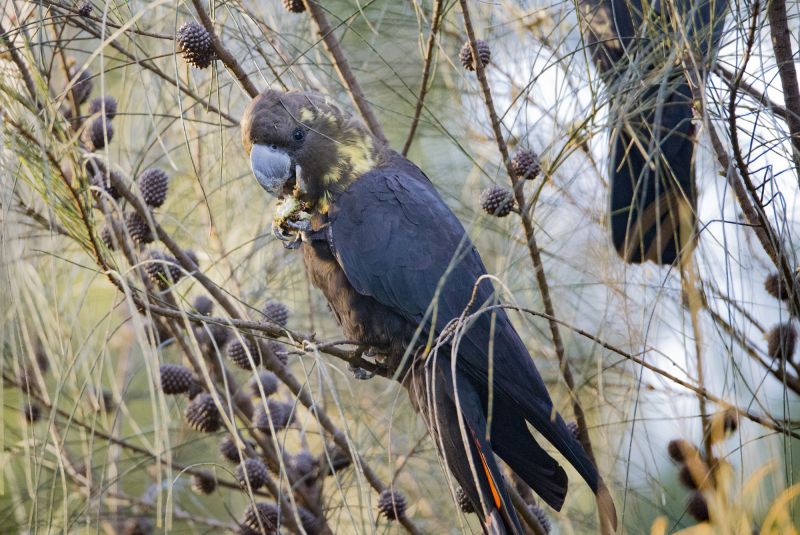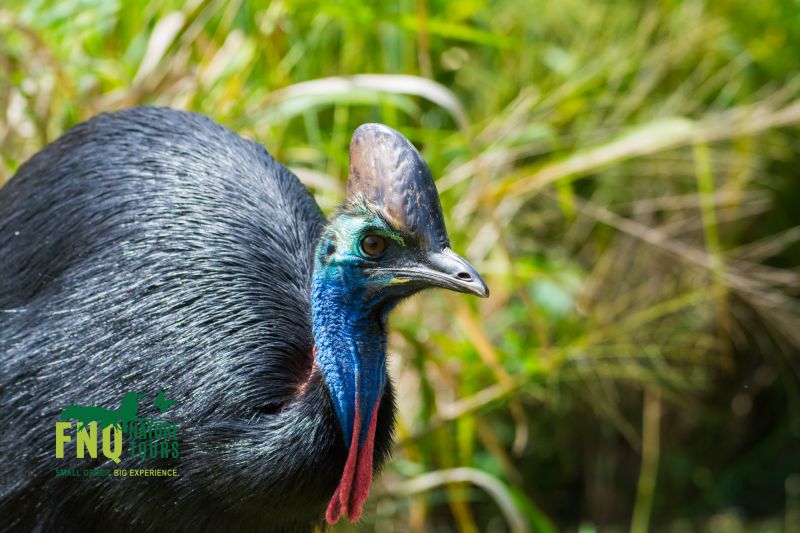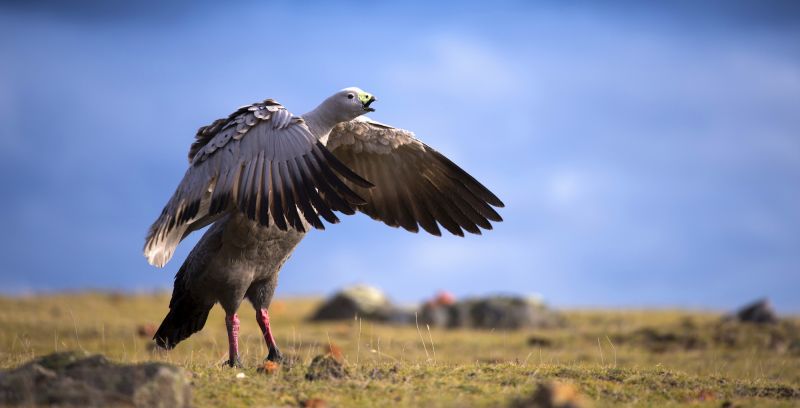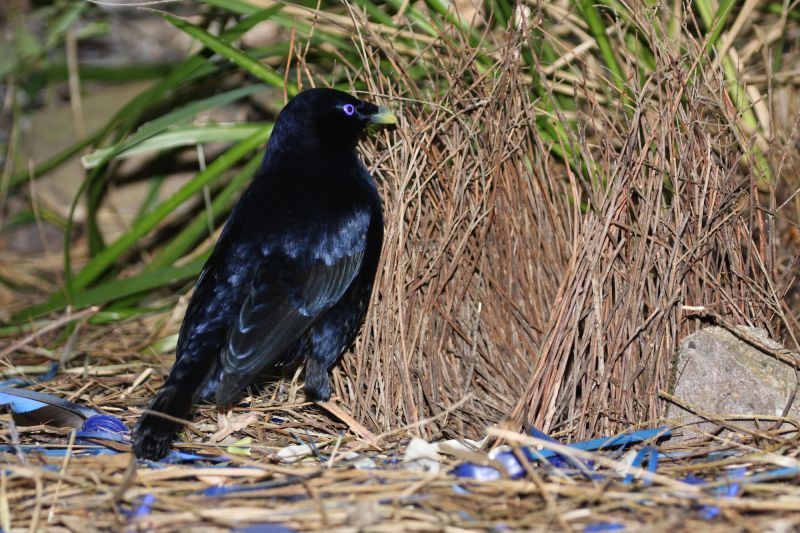Australia is teeming with fabulous quirky birds – birds with extraordinary songs, birds that break eggs with stones, birds that run like the wind, and birds that dance like no one is watching (ironically, these birds are dancing precisely to be watched).
“Some Australian birds have evolved to have amazing foraging, breeding and survival techniques, showing us a glimpse of a truly wonderful and fascinating world,” says Mikala Peters, who works as a marine biologist with Wildlife Coast Cruises. Janine Duffy, co-owner and founder of Echidna Walkabout Nature Tours, wholeheartedly agrees. “Aussie birds are noisy, hyperactive, smart, colourful and obvious. They fill our country with their joy,” she says.
We started off with a top 10 list, but it could easily be a top 100. We’ve gone with a top 11… just because.
01 The show off
Tooth-billed Bowerbird
Colourful and renowned their extravagant dance moves, the birds of paradise are a group of birds found in the rainforests of Papua New Guinea, Indonesia and in the northern part of Australia. “They are well known for their elaborate and passionate dance routines,” explains owner and operator of FNQ Nature Tours’ James Boettcher. “The males often perform these mating rituals while perched in a self-decorated area of the forest. The male Tooth-billed Bowerbird, for example, overturns fallen leaves to create a silver dance floor to impress his potential mate.”
02 The illusionist
Short-tailed Grasswren
Only found in South Australia, these small birds have big personalities – although you need to see them first. “Our endemic Short-tailed Grasswrens are very much a species in recovery and are always a delight to see,” Arkaba’s conservation and general manager Brendon Bevan says. “The little guys are masters of illusion and are incredibly cryptic – they are more often heard rather than seen.”
The grass-eating birds like to hang out among scrubland, and with their well-camouflaged plumage it’s easy to understand why sightings can be challenging. “Although the recovery of their preferred Spinifex habitat has seen populations stabilise and sightings increase, they are still incredibly rare to see – but the potential reward is worth it,” says Brendon.
03 The superstar singer
Superb Lyrebird
There are close to 5000 species of songbirds dispersed around the world, and Echidna Walkabout Nature Tours’ Janine explains that the Superb Lyrebird – a species endemic to Australia – is one of the most special ones. “They are the world’s first songbird and the others have evolved from them,” she says.
The Superb Lyrebird’s syrinx (the bird equivalent of our larynx) is the oldest type and is different in structure to other songbirds, with fewer syringeal muscles. However, it can produce more sounds and variety from its syrinx when compared to many other songbirds (generally having more muscles in the syrinx is associated with a greater depth of vocal complexity). Its mimicking talents are so good that it can even trick other animals into believing it’s one of their own.
This unique bird also has an impressively elaborate tail. “I remember seeing a superb lyrebird male display in the bottom of a rainforest gully in Buchan, East Gippsland, and I finally understood why they have their colour and design,” Janine remembers. “He was singing his heart out, gyrating and pirouetting on his display mound (which he had built himself). Suddenly, a ray of sunshine came through the thick rainforest canopy and hit him at the same moment that he raised his huge tail and shook it! It was like lightning had struck the gully”.
04 The quiet achiever
Glossy Black Cockatoo
“The glossies are pretty atypical of cockatoos,” Craig Wickham, managing director of Exceptional Kangaroo Island explains. “They’re very quiet – rather than raucous – and often the only evidence we have of them being present is a quiet clicking as they shred sheoak cones to extract the seeds, which are their sole food source.”
Sadly, these beautiful birds are now extinct on mainland Australia because of reducing sheoak woodland as a result of climate change. They can only be found on Kangaroo Island, with a steadily rising population thanks to a number of activities such as tree planting and possum-protecting schemes.

Glossy Black Cockatoo
05 The turbo chook
Tasmanian Native Hen
Once found on mainland Australia, these prehistoric-looking birds with brilliant red eyes now only exist in Tasmania – mainly due to lack of predation and an abundance of water.
“The locals call them ‘turbo-chooks’, because they are fast runners and can reach speeds of up to 50 kilometres per hour,” laughs Christina Schulthess, managing director of Premier Travel Tasmania. “They can be seen mostly year-round along road sides, and in grasslands and pastures where they provide much entertainment with their dramatic behaviour – such as gesturing, tail-flicking and amusing chorus-singing which sounds like a cacophony of cross-cut saws.”

Tasmanian Native Hen
06 The stone mason
Black-breasted Buzzard
Black-breasted buzzards are found in central Australia, with a robust population outside Uluru-Kata Tjuta National Park. “You can recognise them when they fly, as you can see the white stripes towards the tips of their wings, which end in finger-like feathers,” says Monica Foster, SEIT Outback Australia’s digital marketing and sales manager. “What is fascinating about these birds in particular is that they use stones to break open large eggs that are too strong for them to break open! They actually pick small rocks up in their beaks and launch them at the eggs to crack the shells open. How cool is that!”

Black-breasted Buzzard breaking eggs with rock
07 The new-age father
Southern Cassowary
After the female cassowary lays the eggs on the forest floor, the rest of the parenting is left in the hands of the male cassowary. The male cassowary first incubates the eggs for 50 days, eating and drinking very little and using his time and energy safeguarding the large eggs and keeping them warm. After the chicks are born they stay close to Dad for up to a year or more. “The male is the maternal parent and the female has no responsibility after laying the eggs! They are smart girls, no?” laughs FNQ Nature Tours’ James Boettcher

Southern Cassowary
08 The dive master
Australasian Gannet
This large mostly-white seabird is found predominantly off Australian and New Zealand coasts, with a few rookeries in Victoria and Tasmania. Its special skillset is its extraordinary diving technique. “Australasian gannets forage out at sea, where they plunge down into the water at high speeds from as high as 30 metres to hunt for fish and squid. They have evolved to have an enforced skull to allow for the impact on the surface,” says Wildlife Coast Cruises’ Mikala Peters. “Many gannets can often be seen dive-bombing into a bait ball off the coast of Phillip Island.”

Australasian Gannet
09 The ‘Spruce Goose’
Cape Barren goose
This large grey goose with a small head became near extinct in the 1950s, but thanks to a number of initiatives, including a successful breeding program, it’s no longer considered to be in danger. “It’s an elegant and grand goose,” says director of Maria Island Walk Ian Johnstone, adding that it honks like a pig and rarely swims.
Today there are populations on the south-eastern coast of Australia, the southern coast of Western Australia and in south-eastern Victoria. The species has also been introduced to Kangaroo Island and Maria Island.

Cape Barren Goose
10 The shy one
Western Whipbird
Rarely seen, but with a loud and distinguishable song call, Western Whipbirds are only found in a few small areas in Southern Australia. “They’re found on the Eyre Peninsula, but they are incredibly shy birds so they are not often seen,” says Fran Solly, one of the Eyre Peninsula’s keenest birdwatchers and guide with Goin’ Off Safaris. “Once seen, they have a tuft of feathers not unlike the Crested Pigeon and the most beautiful song, but it’s likely that even the slightest sound or movement will have them drop back into thick vegetation – so sightings are generally rare and fleeting.”
11 The home decorator
Satin Bowerbird
We now know that bowerbirds like to boogie, but a fact that is interesting about Satin Bowerbirds, is that they take great care in presentation. “The male decorates a love nest with a colour and design that the female adores,” Echidna Walkabout Nature Tours’ Janine explains. “And if you move a piece of a satin bowerbird’s display, he will move it back after you’ve gone. He is an artist, nothing about the design is random.”
When it comes to the beautifying-the-nest process, Satin Bowerbirds gravitate towards anything blue, so they will seek out blue bits and bobs for their artworks. “They use Crimson Rosella wing feathers, flax-lily berries, bluebell flowers and any sort of blue plastic,” laughs Janine. “I've seen clothes pegs, bottle caps, baby's dummies and even chip packets used in their nests!”

Satin Bowerbird at bower with numerous blue objects


